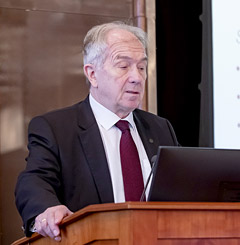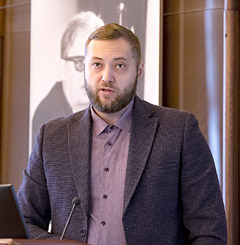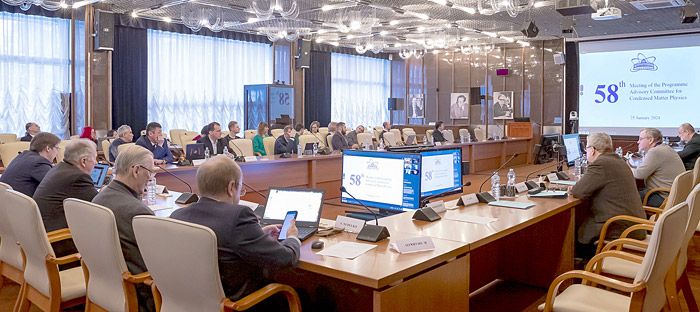
Electronic english version since 2022 |
The newspaper was founded in November 1957
| |
At PAC meetings
About reactors - operating and new
The 58th meeting of the Programme Advisory Committee for Condensed Matter Physics was held on 25 January. It opened with traditional messages: from the Chairman of the PAC D.Nagy - about the implementation of the recommendations of the previous meeting, L.Kostov - about the decisions of the latest sessions of the Scientific Council and the PAC.
E.V.Lychagin reported on the progress of work at the IBR-2 nuclear research facility. He commented on the main provisions of his report at the request of our correspondent:
 |
 |
| L.Kostov | E.V.Lychagin |
"Despite all the uncertainties, we hope that we will be able to put the reactor into operation this autumn. We don't know how Rostechnadzor, a regulatory organization, will react to the expert opinion made by external experts and we have no influence on them. If by April, we receive a new license from Rostekhnadzor, we will do everything possible to put the reactor into operation in November.
We currently work on the manufacturing of new instruments, they are slightly delayed due to the fact that most of the equipment is manufactured abroad and there are problems with the delivery of this equipment to JINR. They are slowly being resolved and there is hope that everything, perhaps with slight delays, will be manufactured and delivered to the Institute."
 |
| M.V.Bulavin |
The main point of the plan is the development of a preliminary design for the NEPTUNE reactor. This is a very important stage from which, in fact, the implementation of the project starts. Currently, we have to select the final configuration of the core that will be worked out in detail within the framework of the preliminary design. The general designer (JSC NIKIET named after N.A.Dollezhal, Rosatom State Corporation) and we have a common understanding of what it should be: this is an original layout in the form of large fuel assemblies (FA) that can be easily and safely installed inside the housing reactor and if necessary, can be easily replaced with new ones. Together with the general designer, we need to finalize this configuration taking into account the dynamics model of pulsed fast reactors that is currently developed by the team of the Sector of the New Source and Moderators Complex of FLNP. This model describes the main reason for the appearance of instabilities (power fluctuations) in pulsed reactors - bending of fuel rods or fuel assemblies in a power pulse and allows one to determine the optimal parameters of the core for stable operation of the reactor. Therefore, the selected layout should not only have feasible design solutions and be justified from the point of view of nuclear safety, but also ensure the oscillatory stability of the new reactor. At the moment, the proposed layout option has been accepted by the general designer for further development.
In parallel with the selection of the core layout, JSC NIKIET currently optimizes the design of the two most critical reactor systems: the vessel and the reactivity modulator, in order to reduce their heating and deformation to an acceptable level. The work is currently carried out under an R&D contract and will be completed in the spring of this year.
The development of neptunium fuel and fuel elements based on it is one of the key goals of the project. Currently, Russia already has the practice of developing experimental fuel assemblies containing the nuclear material neptunium, for example, for afterburning minor actinides in the BN-800 reactor. This is uranium-plutonium MOX fuel that in its composition contains not only plutonium, but also transuranium elements - americium-241 and neptunium-237.
As for fuel elements based on neptunium nitride fuel for the NEPTUNE reactor, to date, there are no prototypes in the industry, therefore, VNIINM named after A.A.Bochvar (Rosatom State Corporation), one of the leading companies in the Russian Federation in the development of nuclear fuel, by order of JINR, should develop a pilot batch of such fuel rods and justify their performance and safety. At the first stage, it is expected to obtain several kilograms of neptunium nuclear material that is the exclusive federal property, to produce a fuel pellet from neptunium nitride and to determine its physical, chemical and technological properties and based on the data obtained, to prepare a technical specification for the development of a preliminary design of a fuel rod for the NEPTUNE reactor.
The selection of the core layout, optimization of the design of the reactor vessel and reactivity modulator to reduce temperature deformations, as well as obtaining the first experimental data on the fuel should ensure the start of the preliminary design stage of the NEPTUNE reactor in 2025 in accordance with the Seven-Year Plan for Development of JINR.
In parallel, preparations are underway to develop an R&D programme to produce a new source. In addition to the stages already announced, this programme includes the development of a reactivity modulator, a set of moderators, various test benches to substantiate the safety of the operation of individual reactor components and the entire reactor installation as a whole, as well as simulation of the experimental infrastructure of the new reactor with prototyping of individual components at the IBR-2 reactor.
An important stage is the development of a scientific programme for a new neutron source, that is currently underway at FLNP."

The results of the meeting of the Programme Committee were summed up by PAC Chairman Denes Nagy in the form of a written interview that has been traditional for recent years.
The current meeting lasted, unlike previous PAC meetings, only one day. E.V.Lychagin and M.V.Bulavin reported on the current work at the IBR-2 facility and on the status of the project for a new promising neutron source at JINR, respectively. How did the Committee evaluate their reports?
- It was an excellent initiative on the part of JINR Directorate and the Scientific Secretary of the PAC Oleg Belov to organize a one-day meeting this time. The meeting was held in a hybrid format; I myself was only able to take part online. Indeed, the reports of Egor Lychagin and Maxim Bulavin were certainly among the main items on the agenda of the meeting. Regarding the report by Egor Lychagin, the PAC took note of the information on the status of obtaining a license to operate the IBR-2 facility and on the preparatory work to replace the air heat exchangers of the second cooling circuit of the reactor. The PAC highly appreciated and supported the plans and efforts of FLNP to resume operation of the IBR-2 facility in 2024-2025. Unfortunately, it does not mean that the user programme can be restored immediately after the intended physical restart of IBR-2; it may be postponed to 2025.
What is your impression of the PAC meeting?
- One of the most important tasks of the PAC is the estimation of projects submitted for closure, opening or renewal, with the peak of this work usually occurring during the summer meetings. This time, we did not engage in such an estimation at all. Actually, this would have been impossible in any case, since none of the reports on the agenda (Gizo Bokuchava, Tatyana Murugova, Pavel Karataev) were considered by experts. It allowed to hold the meeting on one day and make it truly effective.
What impressions did you have from the meeting with Directorate of the Institute?
- Unfortunately, some key persons of JINR Directorate, primarily, Director of the Institute Grigory Trubnikov, were unable to attend this closed event, even remotely. Thus, although we discussed the general aspects of the JINR strategy in detail, the meeting with Directorate ended in 25 minutes instead of the originally envisaged hour.
How did the members of the Committee estimate the numerous poster reports?
- The poster session was held in the traditional online format that in my opinion, should be preserved when hopefully, we return to face-to-face meetings soon. All electronic posters of young scientists are wonderful works worthy of respect. The report by A.Asadov (FLNP) "Phase transitions in Carpi-Gali oxides Ln2Ti2O7 (Ln = La, Nd, Pr) at high pressures" was chosen as the best of 17 virtual stands by secret ballot. The PAC also noted two more high-level virtual poster reports: "The kinetics of the development of double-strand DNA breaks in mature neurons of the primary culture of the rat hippocampus under the influence of radiation of different qualities" by T.S.Khramko (LRB) and "Structural features of fragments of cast-iron cauldrons from the times of the medieval Golden Horde: neutron tomography" by V.S.Smirnova (FLNP). All three authors will be awarded PAC diplomas. In addition, the awarding of diplomas to the winners of previous poster sessions became a new item on the PAC agenda - we would like to maintain this practice in the future. A.Asadov will present his paper and the paper of his colleagues at the upcoming meeting of the JINR Scientific Council on 16 February.
An important item on the agenda was the discussion of approaches to estimating JINR projects. Would you comment on the results of the discussion on this issue?
- The answer is very simple: leave everything as it is; whatever works doesn't need to be revised. Indeed, the PAC discussed the procedures used to estimate JINR projects. The PAC took note of the new rules for the preparation of projects introduced at JINR in 2023 and analyzed the experience of the review procedure that was applied at the 57th meeting of the PAC. The Committee's recommendation was that it considers the current procedures for estimating projects at JINR to be appropriate and recommends their application at future meetings.
Olga TARANTINA,
photo by Elena PUZYNINA